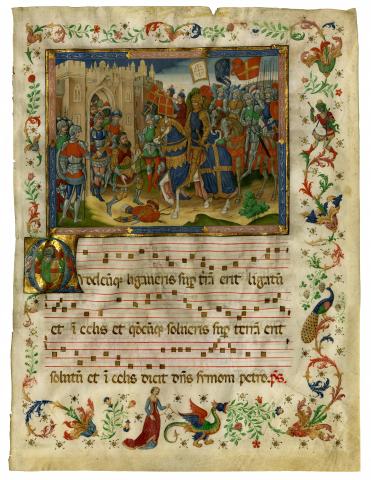Knights of the Crusades Manuscript Leaf
Knights of the Crusades Manuscript Leaf
French (probably Paris), 15th century
Single leaf with miniature added ca. 1900(?)
Language: Latin
ink on vellum
height 24cm
width 19 cm
Ms. leaf from a fifteenth-century Italian manuscript antiphonal on vellum that contains a forged illumination from the late 19th or early 20th century, probably French from Paris, known as the Spanish forger.
A large miniature showing crusading knights arriving at the walls of Jerusalem. The lead knight is fully armed and mounted on a caparisoned horse. The Saracens are shown emerging from the city gate, their leader having just doffed his helmet and laid down his sword and shield in surrender to the victorious Crusaders ... The miniature is painted in the upper half of a full antiphonal leaf on vellum ... Below the miniature are 3 lines of musical notation ... (Bloomsbury Auctions website)
Reed College Library Special Collections, BX875.A2 S63
Jessica Hayes, Medieval Portland Capstone Student, 2016
This leaf has been illustrated with a large miniature on the front, upper half of a fifteenth-century antiphonal manuscript page of vellum. It measures, in total, 190 mm x 240 mm and is considered one of the larger leaves reworked by the Spanish Forger, who was active in Paris in the late nineteenth and early twentieth centuries.[1] The script of the text is Gothic Rotunda. Visible scrapings can be observed where room was made for the miniature illustration at the top of the front of the leaf. The back of the leaf is largely unilluminated and gives an excellent example of what the front would have looked like without the hand of the Spanish Forger. Choral staves, musical notes, and Latin lyrics are visible on the back page of the leaf. The imagery of the miniature depicts knights of the Crusades at the walls of Jerusalem, where the Saracens are visible surrendering just inside the gate.[2]
The leaf has been illuminated extensively on the front at the borders and the first letter with acanthus leaves, a peacock, a lady walking a dragon on a leash, and a man with a drum. The Forger’s trademark techniques can be observed throughout the miniature: extreme head tilt on many of the individuals depicted, the use of incredibly vibrant colors (some of which were inaccessible in the medieval period)[3], the execution of gold leaf as a final touch, and the disjointedness of the original content with the content of the miniatures are just a few of the hallmarks of the Spanish Forger.[4] The choral text on the leaf appears to be from a composition by William Byrd, a popular medieval composer. The composition, Hodie Simon Petrus, commemorates the deaths of Simon and Peter as martyrs:[5]
“Hodie Simon Petrus ascendit crucis patibulum
alleluia
hodie clavicularius regni gaudens migravit ad Christum
hodie Paulus Apostolus, lumen orbis terrae,
inclinato capite, pro Christi nomine martyrio coronatus est
alleluia
Quodcumque ligaueris super terram erit ligatum et in celis
et quodcumque solueris super terram erit solutum et in celis
dicit dominus Simoni Petro.”
"Today Simon Peter mounts the torment of the cross
alleluia
Today the king's key-keeper, rejoicing, has gone to Christ
Today the Apostle Paul, light of the world,
with his head bent down, for the name of Christ was crowned with martyrdom
alleluia
Whatever you have bound on earth you will be bound also in heaven
and whatever you have loosened on earth will be loosened also in heaven.
says the Lord to Simon Peter."
~ Translated by Tim Nidever, Latin Instructor at Portland State University
The image illustrated within the miniature clearly does not correlate with the text of the choral lyrics, clearly demonstrating one of the classic hallmarks of the Spanish Forger.
The Spanish Forger circulated at least 348 forgeries of which we know,[6] showing that the market held great demand for these pieces. The Forger’s pieces are now collected as artistic works in their own right and fetch upwards of $5000 apiece.[7]
Bibliography
Backhouse, Janet. "The 'Spanish Forger'" The British Museum Quarterly 33, no. 1/2 (1968).
Bloomsbury Auctions: Important Printed Books and Manuscripts. April 05, 2008. Accessed November 19, 2016. http://www.bloomsburyauctions.com/cms/pages/lot/NY008/20.
Brett, Philip, Joseph Kerman, and Davitt Moroney. 2007. William Byrd and his contemporaries: essays and a monograph. Berkeley: University of California Press, p. 191.
Burgio, Lucia, Robin JH Clark, and Richard R. Hark. "Spectroscopic investigation of modern pigments on purportedly medieval miniatures by the ‘Spanish Forger.’" Journal of Raman Spectroscopy 40, no. 12 (2009): 2031-2036.
Klein, Ariel. "The Business of Forgery: Puzzles Posed by a Gothic Diptych." PhD diss., University of Michigan, Ann Arbor, 2010.
Voelkle, William M., and Roger S. Wieck. The Spanish Forger. Pierpont Morgan Library, 1978.
Notes
[1] Janet Backhouse. "The 'Spanish Forger'" The British Museum Quarterly 33, no. 1/2 (1968): p. 67.
[2] Bloomsbury Auctions: Important Printed Books and Manuscripts. April 05, 2008. Accessed November 19, 2016. http://www.bloomsburyauctions.com/cms/pages/lot/NY008/20.
[3] Lucia Burgio, Robin JH Clark, and Richard R. Hark. "Spectroscopic investigation of modern pigments on purportedly medieval miniatures by the ‘Spanish Forger.’" Journal of Raman Spectroscopy 40, no. 12 (2009): 2031-2036.
[4] William M. Voelkle, and Roger S. Wieck. The Spanish Forger. Pierpont Morgan Library, 1978, p. 11.
[5] Philip Brett, Joseph Kerman, and Davitt Moroney. 2007. William Byrd and his contemporaries: essays and a monograph. Berkeley: University of California Press, p. 191.
[6] Ariel Klein. "The Business of Forgery: Puzzles Posed by a Gothic Diptych." PhD diss., University of Michigan, Ann Arbor, 2010: p. 15.
[7] Bloomsbury Auctions: Important Printed Books and Manuscripts. April 05, 2008. Accessed November 19, 2016. http://www.bloomsburyauctions.com/cms/pages/lot/NY008/20.

